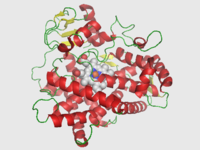
Photo from wikipedia
A neural network model trained on full CYP2D6 gene sequences increases the ability to predict CYP2D6-mediated tamoxifen metabolism. A prescription for dosing prediction The highly polymorphic enzyme cytochrome P450 2D6… Click to show full abstract
A neural network model trained on full CYP2D6 gene sequences increases the ability to predict CYP2D6-mediated tamoxifen metabolism. A prescription for dosing prediction The highly polymorphic enzyme cytochrome P450 2D6 (CYP2D6) processes about a quarter of clinically used drugs. However, its activity varies widely between individuals, affecting drug response. Useful but imperfect *-allele categories are currently used to estimate per-individual CYP2D6 activity and refine patient drug dosages as needed. Instead, van der Lee et al. trained a neural network on entire CYP2D6 gene sequences to model enzyme activity on a continuous scale. When applied to independent cohorts of patients treated with tamoxifen or venlafaxine (both CYP2D6 substrates), the model resulted in a moderate improvement in the prediction of individual drug response, laying the groundwork for more accurate CYP2D6 pharmacogenomics. Pharmacogenomics is a key component of personalized medicine that promises safer and more effective drug treatment by individualizing drug choice and dose based on genetic profiles. In clinical practice, genetic biomarkers are used to categorize patients into *-alleles to predict CYP450 enzyme activity and adjust drug dosages accordingly. However, this approach leaves a large part of variability in drug response unexplained. Here, we present a proof-of-concept approach that uses continuous-scale (instead of categorical) assignments to predict enzyme activity. We used full CYP2D6 gene sequences obtained with long-read amplicon-based sequencing and cytochrome P450 (CYP) 2D6–mediated tamoxifen metabolism data from a prospective study of 561 patients with breast cancer to train a neural network. The model explained 79% of interindividual variability in CYP2D6 activity compared to 54% with the conventional *-allele approach, assigned enzyme activities to known alleles with previously reported effects, and predicted the activity of previously uncharacterized combinations of variants. The results were replicated in an independent cohort of tamoxifen-treated patients (model R2 adjusted = 0.66 versus *-allele R2 adjusted = 0.35) and a cohort of patients treated with the CYP2D6 substrate venlafaxine (model R2 adjusted = 0.64 versus *-allele R2 adjusted = 0.55). Human embryonic kidney cells were used to confirm the effect of five genetic variants on metabolism of the CYP2D6 substrate bufuralol in vitro. These results demonstrate the advantage of a continuous scale and a completely phased genotype for prediction of CYP2D6 enzyme activity and could potentially enable more accurate prediction of individual drug response.
Journal Title: Science Translational Medicine
Year Published: 2021
Link to full text (if available)
Share on Social Media: Sign Up to like & get
recommendations!